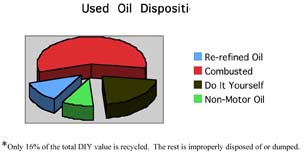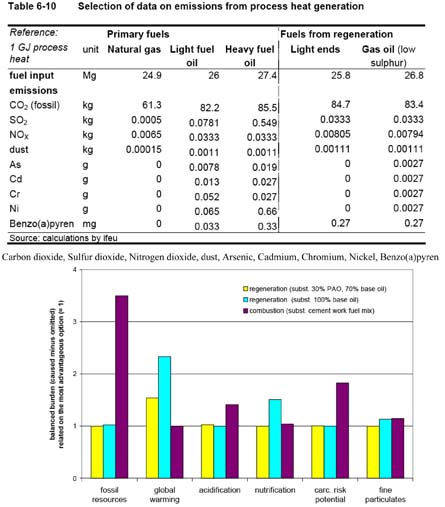 |
 |
 |
 |
 |
 |
 |
 |
|
The complete study, "The Environmental Impact of Re-Refining Used Motor Oil" (10/12/2006) can be accessed by clicking here. Status of Recycled Oil in the US
*Only 16% of the total DIY value is recycled. The rest is improperly disposed of or dumped. The limited amount of re-refining is attributed to the high cost involved in building and maintaining a re-refining plant. The DOE estimates this ranges from $4-$17 million to produce between 5 and 24 million gallons of recycled oil where hydrogen is used, $5-$7 million to produce 7-10 million gallons where clay regeneration is used, and $17- $21 million to produce 15 million gallons where partial hydrogenation is used. In November of 2006, Totale announced construction of a re-refinery in France to produce 35 million gallons of re-refined motor oil at a cost of Euros 50 million, thus calling into question the DOE estimates. Re-Refining Process Re-Refining Environmental impact The environmental impact of re-refining is a substantial improvement over burning with respect to human toxicity potential, heavy metals, eutrophication potential, aquatic ecotoxicity, carcinogenic substances, photochemical oxidant potential and acidification potential. Byproducts from the recycling process -- diesel fuel and asphalt-- can be sold in their own right, thereby limiting waste from the process. Positive Impact By increasing the number of re-refineries in the U.S., Omega will increase the amount of actual recycled oil on market. Currently there are less than 20 operators of used oil recycling refineries and most are involved in refining their own product. The re-refining process recovers the heating value of hydrocarbons and recaptures chemical makeup suitable for use as a premium hydrocarbon product for manufacturing lube oils. Therefore, the product that this system produces may be used for a variety of products and so long as the end use isn’t fuel, those products may be refined again and again. Because the re-refining process is not involved in dumping or delivering used oil in landfills or bodies of water, the process avoids drinking water contamination. Comparison The preservation of energy as an environmental consideration favors re-refining or combustion in larger industrial applications. The energy balance favors re-refining because the energy consumption that occurs during the distillation and hydrotreating is less than that consumed in burning the used oil as fuel or in space heaters. Emissions Reviewing the environmental parameters and the impact of burning the used oil, assuming no pollution controls, the alternative of re-refining used oil produces the smallest negative environmental impact. The heavy metals emissions may lead to 150 times the ecotoxicity impacts compared to re-refining if air pollution control technology is not used. The metals emissions from space heaters are approximately 50% of the input feed, thus the toxicity impact is prorated accordingly to a factor of 75. To put this in perspective, the California EPA study estimated that the zinc emissions from space heaters alone amount to approximately 7% of the total U.S. zinc air emissions. Combustion of used oil results in air emissions. However, the magnitude of emissions depends on the quality of the air pollution control equipment utilized. Space heaters have even higher emissions than any other type of used oil combustion process because they do not feature any emissions control equipment. While many large scale industrial applications that feature air pollution control equipment are capable of emitting metals within allowable limits, the re-refining process emits the least amount of metals. Federal Involvement Further, the U.S. does have a mandatory federal policy requiring the preferential purchase of re-refined oil and does promote the source reduction and recycling of materials over their treatment and disposal under the Resource Conservation Recovery Act and the Pollution Prevention Act. Twenty–five percent of the total worldwide consumption of lube oils occurs in the United States. The amount of oil consumed by the U.S. represents 21.3% of the world’s Gross National Product. However, most European countries have implemented oil recycling programs that are far more advanced and regulated. A logical response to worldwide oil consumption is a more responsible recycling policy as well as more involvement and production by private oil re-refineries. Forecasts |
||||
|
|
||||
|
About CheyenneX ||| Re-Refineries ||| Oil Recycling Process ||| Resource Conservation ||| FAQs & Links ||| Contact Us ||| Home Page
|
||||
Christopher Findlater NetQuote Website Design Development Hosting Annual Report Design Pite Creative Colorado


